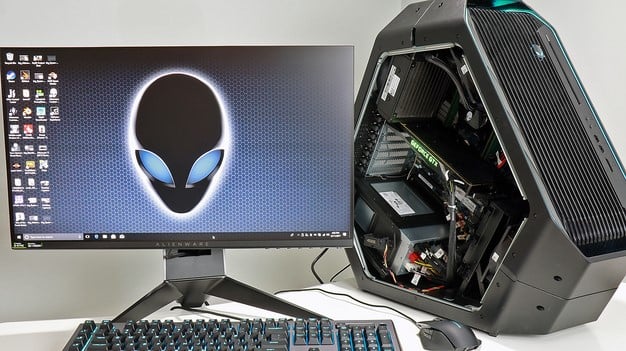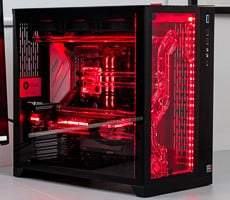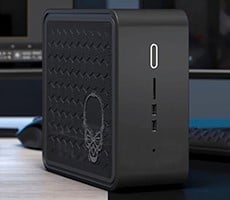There are generally two camps of enthusiast PC gamer: those who want ultimate horsepower for ultra-high resolution 4K gaming and super-fast twitch types that want screaming high frame rates to go with fast display refresh times for buttery precision. In concert with the latter group of speed freaks,
gaming monitors, along with its Pro Gaming keyboard, and Advanced Gaming mouse to round out the package.


We'll get back to external trimmings in a bit but we're sure many of you are of the opinion that it's what's on the inside the counts most. Fortunately, getting access to the Area-51's internals is as easy as pulling up on a small lever on the top of the chassis that then releases the side panel. Alienware designed the machine for extremely serviceable, easy access and it's actually easier to pop open the side panel on this system than it is on most custom DIY PC cases on the market currently.

Once inside we're treated to some rather well-thought-out floor planning in a standard ATX format, but in a rather unorthodox chassis design. All of the major components are mounted pointing up on a 45-degree angle and though the motherboard area has to orient the Alienware's custom AMD Threadripper motherboard in a triangular shaped area, it all works surprisingly well and is almost completely tool-less. There's plenty of real estate around the TR4 CPU socket area to work with quad-channel DDR4 memory module kits, as well as the custom Alienware TR4 AiO cooler pump and cold plate assembly. Though we don't show it here, the copper cold plate of the cooler is actually a standard, round-shaped Asetek-type, but with an offset mounting bracket that matches up with the TR4 socket. Though it doesn't completely cover an AMD Threadripper CPU heatspreader, with its massive, rectangular shape, both AMD and Dell note that its more than adequate to keep the chip cool, even while overclocked, which we'll look at more closely on the pages ahead.

The other unique feature of all
Area-51 systems is its graphics card "cage", for lack of better geek terminology. Graphics cards are mounted in typical fashion on the motherboard with locking slot mechanisms and press-fit, backside IO bracket clips. However, the rear of each card mounted in the system (near its
PCIe power connectors) has a metal backplate that slides into a metal cage, that's positioned in front of a front air-intake fan, and is secured in place with a plastic retention clip. This custom config not only keeps GPUs secure and in place for shipping and transit, but it also delivers direct airflow over the PCIe slot area in general, pulling cool air in for any card in a slot to exhaust out its back slot plate. The design works really well and is one of our favorite features of the system. Also seen here between two PCIe x16 slots, is the mezzanine style M.2 socket for the Area-51's
NVMe SSD -- an efficient use of PCB area similar to what we've seen on other OEM motherboard designs.

The backside of the motherboard and right side panel area of the Area-51 was not left to waste by Dell. Here we have various 3.5-inch and 2.5-inch storage bays ready to take on bulk storage tasks beyond the OS volume that might reside on that speedy NVMs SSD. Our system came configured with a 2TB Toshiba 7200 RPM SATA Hard Drive, which handled our bulk storage needs just fine.
Let's pause and digest for some geek gallery action...




So, aside from the cool, coordinated Alienware
RGB lighting (with 16.8 million ambient color options), keyboard aficionados should take note that this deck (
Alienware model AW768) is based on Kalih switches. These are full mechanical switches with a solid tactile bump at the actuation point, but perhaps slightly less satisfying versus true Cherry switches. They're a step up from rubber membrane dome switches, but some may feel they're not quite on the level of a true Cherry-based deck. Regardless, for a $99 asking price, this board will deliver for all but the most ardent keyboard snobs, our own Marco Chiappetta notwithstanding.
Further, the Alienware
AW958 Elite Gaming Mouse, seen above, may just make the cut here as a daily driver, with 16.8 million RGB colors, 12000 DPI precision, and up to 50 grams of counter-weights for critical mass. With interchangeable, snap-on, magnetized side button configurations, we'll give it a whirl. It strikes a balanced feel in the hand, and for $69 retail, inspires precision cursor or reticle control.



Alienware's
AW2518H 25-inch, 240Hz, NVIDIA G-Sync equipped gaming monitor is one of the fastest pixel pushing panels we've ever seen here. It's built like a tank, with both vertical adjustments, a tilt / pivot hinge and swivel for complete control of display orientation. This thing has a blistering-fast 1ms response time with virtually no input lag, and with NVIDIA
G-Sync adaptive refresh technology and compatible
GeForce graphics card, you simply can't get a more responsive, smoother window on your gaming world. For creative professionals, its pedestrian 1920x1080 resolution and 25-inch diagonal screen area might be a limiting factor, but for hard core, fast twitch gamers this is about as close as you get to real-time rendering, lag and jitter-free on a display currently.
This display also has Alien-FX
RGB lighting that can be controlled via Alienware's Control Center software, in order to coordinate your illuminated gaming color schemes in complete unison. Here's a quick look at some of the tools Alienware offers...

Right now, Alienware's keyboard and mouse Control Center software is separate from the Alien FX software that configures the lighting for the rest of the system. AlienFX goes a few steps further, allowing control and monitoring of system health, fans speeds and environment settings, along with profile functions to engage custom system setups and user-configured gaming profiles. AlienFX has been around for years, and is largely the same in this version of the Area-51. However, in the future, Alienware will be rolling out a significantly more integrated solution, and that's all we can say for now. Let's just say stay tuned to our
CES 2018 coverage in the days ahead.
Right then, let's drop the hammer, shall we?

















